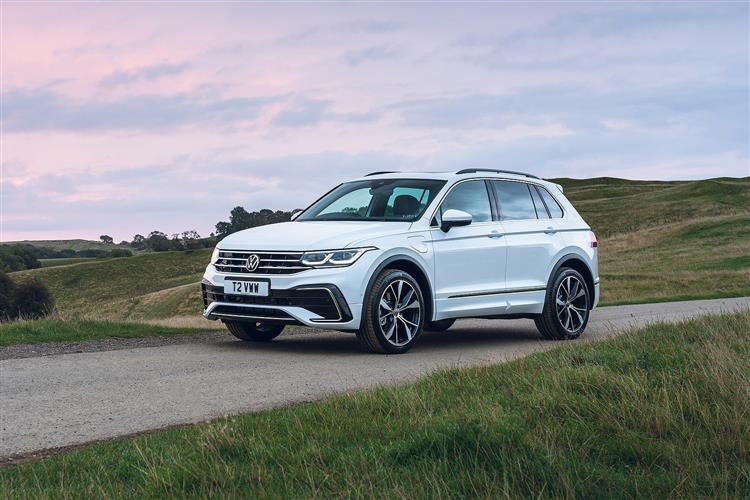HY-ER ASPIRATIONS (some text hidden) --NONE--
By Jonathan Crouch
Introductionword count: 75
Launched in 2021, the original AD/BW-series version of Volkswagen's Tiguan eHybrid used an established VW Group PHEV powertrain to deliver a 28 mile all-electric driving range and lots of e-drive options. It was the same sort of thing obvious volume brand mid-sized SUV plug-in competitors of the period offered, but here, the technology was delivered with a bit more polish. As a used proposition, there's lots to like if you don't mind the premium pricing.
Modelsword count: 5
5dr SUV (1.4 TSI PHEV)
Historyword count: 149
The Tiguan eHybrid was a long time in coming. Volkswagen was talking about a PHEV plug-in version of its mid-sized SUV even before the AD/BW-series second generation Tiguan was first launched in 2016 and showed a Tiguan GTE prototype to gauge public reaction. This concept car had a clever roof-mounted solar module that potentially could add around 300 further miles to the all-electric range figure - which we were eager to see. Sadly, that technology never made it through to production. And probably wouldn't have been much use in drizzly Blighty anyway. What we did get though in this finished Tiguan eHybrid model was plenty of cutting-edge technology, even though the powertrain used here wasn't that much different from the one first introduced in a Golf GTE back in 2014. Still, it was enough to sustain the Tiguan eHybrid until an all-new longer-range MK3 version arrived in late 2023.
What You Getword count: 642
Unless you spot the extra charging flap or the distinct badging, you're unlikely to notice that this eHybrid variant is different from any other Tiguan. This PHEV model only came with the conventional five-seat body style and features all the visual updates applied to the MK2 Tiguan around the time of this PHEV model's launch. Which means you get a wide grille with an extra lower chrome strip that forges a visual link between the Tiguan and pricier Volkswagen SUVs such as the larger Touareg and the huge Atlas Cross Sport model sold in North America. The standard full-LED headlights which flank this appendage could optionally feature the company's latest IQ.Light matrix technology, which gives you 24 LEDs in each module. From the side, you notice that this MK2 model Tiguan is larger than it looks - more of a rival to upper mid-sized SUVs like Ford's Kuga than to smaller mid-sized models like Nissan's Qashqai. Wheel sizes start with 18-inch rims, rising through 19-inchers to 20-inches in size on the top 'R Line' version. At the back, there are three-dimensional tail lights. Beneath these two-part lamps, the large tailgate extends to each side, while lower down, there's an integrated diffuser with a granite grey metallic finish. At the wheel, there's a premium-style feel that you just don't get from most competing volume brand mid-sized PHEV crossovers from this period. You sit quite commandingly and the build quality and general ergonomics are difficult to fault. Through the leather-stitched wheel, you view an instrument panel that features Volkswagen's 'Digital Cockpit Pro' 10.25-inch high-resolution screen. This customises its layout to your preference in the presentation of the two main dials - which can be configured to show everything from efficiency stats to off road information. And you can separately individualise a display between them which can showcase a whole range of different data but which looks most sophisticated when it's showing a navigation map. There are various E-specific read-outs which you'll also find on the 8-inch 'Discover Media' centre screen (which original owners could upgrade to 9.2-inches). The presentation of this display is smart and what's behind it is equally sophisticated, based around Volkswagen's MIB3 media platform. Enough on infotainment: what else might you need to know about the front cabin of this Tiguan? We talked about the near-premium feel earlier. True, if you really are being picky, you'll find some lower-grade scratchier plastics lower down the dash and the door cards, but for the most part, everything feels polished, classy and meticulously designed; take these narrow, precisely-worked aluminium frames around the air vents for example. Everything falls perfectly to hand and, predictably, the ergonomics are pretty faultless - take for instance, the subtle orientation of the dashboard towards the driver. The back seat is one of the more spacious ones you'll find in the mid-sized segment from this period, but the main reason we like it is that Volkswagen integrated a sliding feature so that you can prioritise either legroom or boot space behind. That's something you have to do without on many rivals, even premium badged ones. There's 180mm of back-and-forth adjustment. Headroom's fine too - though you will compromise it a little if you get a car fitted with the optional panoramic glass roof. It's nice to note that the seatbacks recline for greater comfort on longer journeys. And the central transmission tunnel isn't as awkwardly prominent as it is in some competitors, so if you do have to accommodate three adults back here, things will be slightly easier for the middle occupant. Out back, boot space falls by 137-litres because of the need to place the PHEV system's battery beneath the cargo area floor. That means a 437-litre boot capacity - though you can extend that via a standard ski hatch - or of course by folding the 40:20:40-split-rear bench.
To see the full road test text contact us on 0330 0020 227
Pictures (high res disabled)

.jpg)
|
.jpg)
|
.jpg)
| |||
.jpg)
|
.jpg)
|
.jpg)
| |||
.jpg)
|
.jpg)
|
Scoring (subset of scores)
Category: Hybrid, Plug-in, Electric & Hydrogen
| Performance | |
| Handling | |
| Comfort | |
| Space | |
| Styling, Build, Value, Equipment, Depreciation, Handling, Insurance and Total scores are available with our full data feed. | |



